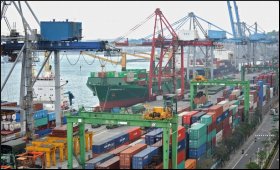
In its push for greater connectivity with ASEAN countries, India is focussing its attention on a deep-sea port in southern Myanmar that would provide a much shorter sea route to the economically vibrant Southeast Asian region and help boost trade.
The Dawei deep sea port and special economic zone is slated to give a huge boost to connectivity and trade in the Southeast Asian region when it is commissioned in a few years. The $8-billion project is being developed jointly by Myanmar and Thailand.
"The Dawei deep sea port, when complete, will provide India an alternative sea route to Southeast Asia and reduce dependency on the congested Strait of Malacca and cut transport time," an official told agency.
The Dawei port is part of the southern corridor of the Mekong India Economic Corridor. India is concentrating on the southern economic corridor, which would connect Ho Chi Minh City in Vietnam, Phnom Penh in Cambodia, Bangkok in Thailand to Dawei in Myanmar.
"When Dawei port is ready, India is planning to connect it with Chennai. There will be no need to go through the Strait of Malacca then," said the official, unwilling to be named.
During Prime Minister Manmohan Singh's visit to Thailand last May, the Thai government invited Indian business to invest in the Dawei Special Economic Zone, especially in areas where Indian companies have expertise, such as steel, manufacturing, power, petrochemicals and services.
Thailand's construction giant Italian-Thai Development Co has been involved in construction of the deep-sea port, which is designed to accommodate ocean-going cargo ships that pass through the Indian and Pacific oceans, cutting short the maritime distance over a relatively long detour via Singapore.
The Dawei Special Economic Zone Development Co, jointly owned by Thailand and Myanmar, will be assigned to run the project.
The Greater Mekong sub-region also has a North-South corridor linking cities of the Mekong basin countries - Cambodia, Laos, Myanmar, Thailand and Vietnam - to China. But India is not keen to join this. "That corridor cuts across to China and India is not very keen to join it," said the official.
India is involved in the 1,400-km Trilateral Highway, linking India, Myanmar and Thailand, that is slated to become a reality by 2016.
The highway - from Moreh in Manipur to Mae Sot in Thailand via Myanmar - would open up India's landlocked northeast to Southeast Asia. The project is being funded by the Asian Development Bank.
The highway is expected to allow freight and container trucks to move across the borders from India to Myanmar and Thailand and play a crucial role in boosting trade and investment in the three countries.
The Kalewa-Yargi section of the highway in Myanmar, which India has offered to upgrade, is facing some problems due to the hilly terrain, said the source.
"The major chunk of the Trilateral Highway has been completed. On the Kalewa-Yargi section and upgradation and repairing of 71 bridges, which India had agreed to undertake during Manmohan Singh's visit to Myanmar in May 2012, work is on," the official added.
India and the 10-nation ASEAN countries of Brunei, Cambodia, Indonesia, Laos, Malaysia, Myanmar, the Philippines, Singapore, Thailand and Vietnam have a combined population of 1.8 billion, which is one-fourth of the global numbers. The combined GDP of India and the regional bloc is around $3 trillion.
Among other connectivity projects with the bloc, India is also helping Myanmar upgrade the 160 km Tamu-Kalewa-Kalemyo road, repairing 71 old bridges in Myanmar, besides building the Kaladan multi-modal transit transport project.
The Kaladan project, expected to be completed in 2014, will connect Kolkata port with Sittwe port in Myanmar by sea and also link Sittwe to Mizoram via river and road transport.